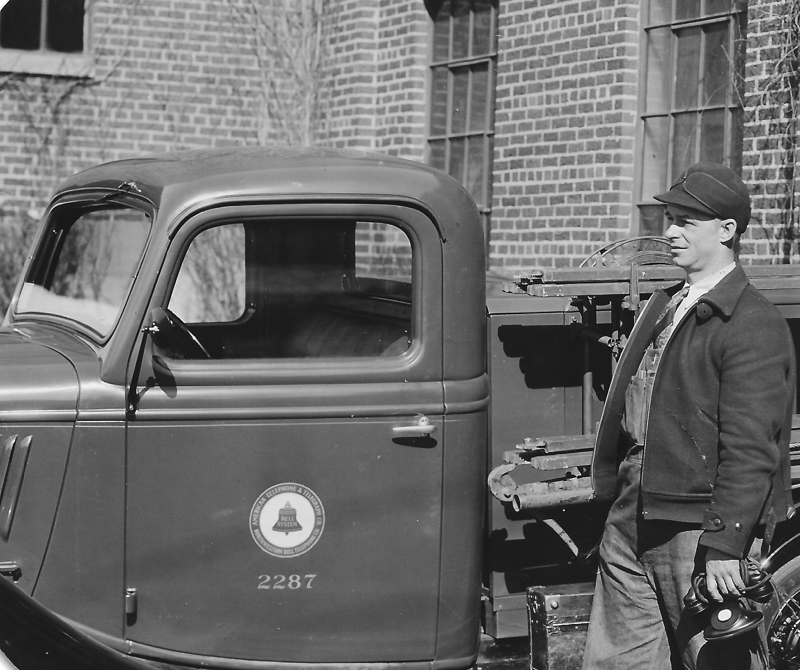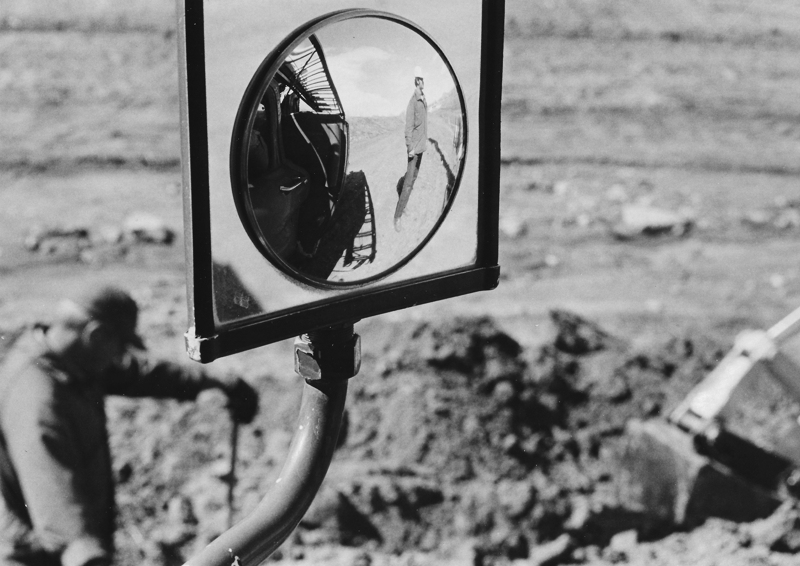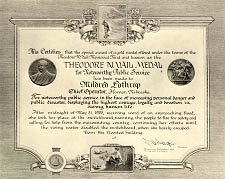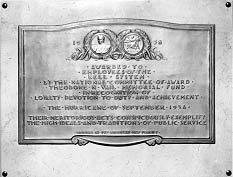
Image of Wesley R. Schulz (THG file photo)
Telecom Heroes
Wesley Schulz
While preparing to install a telephone in Portland, Oregon, at about 3:50 P.M. on March 24, 1948, Wesley Schulz, a station installer for the Pacific Telephone & Telegraph Company, heard the cry of “cave-in” from construction company workers engaged in digging a sewer trench about a block away. He hurried in his truck to the excavation, where he was told that two crew members had been buried under twelve feet of moist, sandy soil when the walls of the trench collapsed.
Disregarding personal danger, Mr. Schulz got the 24-foot ladder from his truck, lowered it into the hole, and climbed down. With the assistance of others who followed him, he began to dig with his hands in an attempt to locate the buried men. After about 30 minutes of digging, he succeeded in partly uncovering one of the men who, although conscious, was breathing with difficulty and in considerable pain. Mr. Schulz applied an oxygen mask furnished by a city fireman and removed the dirt from the man’s chest and back to relieve pain and pressure. He was unable to remove him immediately, as the man’s legs were entangled with those of his fellow worker, who was still buried.

Wesley Schulz (THG file photo)
In his efforts to free the two men, Mr. Schulz worked continuously for more than two hours in the face of great personal danger from additional cave-ins. His display of fortitude, courage, and initiative was highly commended by other rescue workers and observers, and through his heroic efforts, under hazardous conditions, he contributed materially to the saving of a life.
Schulz’s brave efforts were recognized with a Silver Vail Medal


Definition
The Vail Medal
The Vail Medal was created in 1920 in memory of Theodore N. Vail (President of the American Telephone and Telegraph Company from 1907 to 1919) to perpetuate his ideals of service to the public. The medal, which bears his likeness, was awarded to individuals for noteworthy acts reflecting the Bell System's highest traditions of loyalty and devotion to duty.
Adolph Alexander Weinman, one of the leading sculptors in the United States, designed the Vail Medal in 1921. In designing the medal, Mr. Weinman captured not only the personality of Vail, but also his ideals of service to the public.
The face of the medal bears a portrait of Vail, while on the reverse, the central figure represents the "Civilizing Force of Communication" speeding the winged message along the wires. At the right, "Loyalty to Service" upholds the left hand of the central figure, while a third figure, "Devotion to Duty," helps to support the lines of communication.
 There are three types of Vail Medals: bronze, silver, and gold. Bronze medals were awarded to individuals in each Bell System company by that company's awards committee. A Bell System Committee then reviewed these cases and selected those of "especially outstanding excellence or importance" for silver or gold medal awards.
There are three types of Vail Medals: bronze, silver, and gold. Bronze medals were awarded to individuals in each Bell System company by that company's awards committee. A Bell System Committee then reviewed these cases and selected those of "especially outstanding excellence or importance" for silver or gold medal awards.
A bronze medal was also awarded to groups of employees where the noteworthy act was due to the concerted action of the group, rather than by an individual.
An embossed citation certificate, with a brief description of the circumstances that occasioned the award, was given to each Vail Medal recipient. (The one pictured is Millie Lothrop's.) A bronze plaque commemorating the act was presented to the company concerned. These plaques were designed for display in telephone buildings as a permanent and public memorial. Plaques may be seen to this day in telephone company buildings across the nation.
 Up to the breakup of the Bell System in 1984, hundreds of awards were made to telephone company employees who embodied the ideal of service (see Heroes for some representative stories). Men and women of the Bell System performed acts of public service and bravery ranging from struggling through a blizzard to fix a downed line; saving a child from a burning building or a man from a raging flood; to staying at the switchboard while bullets flew—and were celebrated with the award of a Vail medal.
Up to the breakup of the Bell System in 1984, hundreds of awards were made to telephone company employees who embodied the ideal of service (see Heroes for some representative stories). Men and women of the Bell System performed acts of public service and bravery ranging from struggling through a blizzard to fix a downed line; saving a child from a burning building or a man from a raging flood; to staying at the switchboard while bullets flew—and were celebrated with the award of a Vail medal.
From For Noteworthy Public Service: Theodore N. Vail Medals National Awards, 1950.
Telecom Heroes
Wesley Schulz

Image of Wesley R. Schulz (THG file photo)
While preparing to install a telephone in Portland, Oregon, at about 3:50 P.M. on March 24, 1948, Wesley Schulz, a station installer for the Pacific Telephone & Telegraph Company, heard the cry of “cave-in” from construction company workers engaged in digging a sewer trench about a block away. He hurried in his truck to the excavation, where he was told that two crew members had been buried under twelve feet of moist, sandy soil when the walls of the trench collapsed.
Disregarding personal danger, Mr. Schulz got the 24-foot ladder from his truck, lowered it into the hole, and climbed down. With the assistance of others who followed him, he began to dig with his hands in an attempt to locate the buried men. After about 30 minutes of digging, he succeeded in partly uncovering one of the men who, although conscious, was breathing with difficulty and in considerable pain. Mr. Schulz applied an oxygen mask furnished by a city fireman and removed the dirt from the man’s chest and back to relieve pain and pressure. He was unable to remove him immediately, as the man’s legs were entangled with those of his fellow worker, who was still buried.

Wesley Schulz, THG file photo
Mr. Shultz was continuing to dig for the other man when the walls of the excavation collapsed a second time, covering him up to his chest. Fortunately, he remained erect and, in doing so, was able to prevent some of the dirt from falling on the others assisting in the rescue. He was soon free and continued his efforts to rescue the other buried man. This man was partly uncovered by Mr. Schulz about 15 minutes later. At that point there was room enough in the trench for only Mr. Schulz and one other worker, a doctor, who administered oxygen and adrenaline to the second man, but he failed to respond and was pronounced dead. The first man was removed at about 5:15 P.M., and the body of the second man was taken out at 6:00.
In his efforts to free the two men, Mr. Schulz worked continuously for more than two hours in the face of great personal danger from additional cave-ins. His display of fortitude, courage, and initiative was highly commended by other rescue workers and observers, and through his heroic efforts, under hazardous conditions, he contributed materially to the saving of a life.
Schulz’s brave efforts were recognized with a Silver Vail Medal


Definition
The Vail Medal
The Vail Medal was created in 1920 in memory of Theodore N. Vail (President of the American Telephone and Telegraph Company from 1907 to 1919) to perpetuate his ideals of service to the public. The medal, which bears his likeness, was awarded to individuals for noteworthy acts reflecting the Bell System's highest traditions of loyalty and devotion to duty.
Adolph Alexander Weinman, one of the leading sculptors in the United States, designed the Vail Medal in 1921. In designing the medal, Mr. Weinman captured not only the personality of Vail, but also his ideals of service to the public.
The face of the medal bears a portrait of Vail, while on the reverse, the central figure represents the "Civilizing Force of Communication" speeding the winged message along the wires. At the right, "Loyalty to Service" upholds the left hand of the central figure, while a third figure, "Devotion to Duty," helps to support the lines of communication.
 There are three types of Vail Medals: bronze, silver, and gold. Bronze medals were awarded to individuals in each Bell System company by that company's awards committee. A Bell System Committee then reviewed these cases and selected those of "especially outstanding excellence or importance" for silver or gold medal awards.
There are three types of Vail Medals: bronze, silver, and gold. Bronze medals were awarded to individuals in each Bell System company by that company's awards committee. A Bell System Committee then reviewed these cases and selected those of "especially outstanding excellence or importance" for silver or gold medal awards.
A bronze medal was also awarded to groups of employees where the noteworthy act was due to the concerted action of the group, rather than by an individual.
An embossed citation certificate, with a brief description of the circumstances that occasioned the award, was given to each Vail Medal recipient. (The one pictured is Millie Lothrop's.) A bronze plaque commemorating the act was presented to the company concerned. These plaques were designed for display in telephone buildings as a permanent and public memorial. Plaques may be seen to this day in telephone company buildings across the nation.
 Up to the breakup of the Bell System in 1984, hundreds of awards were made to telephone company employees who embodied the ideal of service (see Heroes for some representative stories). Men and women of the Bell System performed acts of public service and bravery ranging from struggling through a blizzard to fix a downed line; saving a child from a burning building or a man from a raging flood; to staying at the switchboard while bullets flew—and were celebrated with the award of a Vail medal.
Up to the breakup of the Bell System in 1984, hundreds of awards were made to telephone company employees who embodied the ideal of service (see Heroes for some representative stories). Men and women of the Bell System performed acts of public service and bravery ranging from struggling through a blizzard to fix a downed line; saving a child from a burning building or a man from a raging flood; to staying at the switchboard while bullets flew—and were celebrated with the award of a Vail medal.
From For Noteworthy Public Service: Theodore N. Vail Medals National Awards, 1950.
back to top
back to Susan Parks
on to Andrew V. Smith